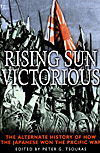 Greenhill, 2001, £ 18.95, ISBN 1-85367-446-X, 256 pages
Greenhill, 2001, £ 18.95, ISBN 1-85367-446-X, 256 pages
Ten essays discuss how various Japanese operations could yield a victory. Some merely extrapolate events had one commander or another been more (or less) aggressive. Others are, shall we say, quite the stretch and rely on a considerable number of circumstances to occur. Others are a mix of the two extremes.
For example, the chapter on Pearl Harbor supposes a third wave on the oil tanks, docks, and other infrastructure. It also supposes the USS Nevada had been sunk in the channel instead of beached and that the USS Enterprise had been around Hawaii instead of delayed by a storm at sea. The end result? The US takes six months to re-open Pearl Harbor, in the meantime falling back to the US west coast and leaving the Imperial Japanese Navy full freedom in the Pacific for other operations. By the way, Admiral Kimmel dies in the attack and becomes an American hero, not a scapegoat.
In another example, the Battle of Leyte Gulf, Admiral Kurita steels his nerves and pushes forward through the San Bernardino Strait, brushing aside the US escort carriers and destroyers, and ultimately destroying most of the Phillipines invasion fleet. Halsey is sacked, Roosevelt offers the Japanese terms because even US production will take a year or two to make good the losses, and Japan keeps all territory occupied prior to December 7, 1941.
On the other hand, a Japanese invasion of India at Calcutta and subsequent conquering of most of the country relies on a considerable amount of British bungling and Japanese fortune. Likewise, the invasion of the Japanese home islands postulates that four atomic bombs failed to persuade the Japanese to surrender--indeed, the bombs cause a coup that overthrows the Emperor and unleashes a kamikaze attack that ravages the American fleet. Even more atomic bombs are then used in a tactical sense. US casualties mount and both sides agree o an armistice to end the casualty stream.
I should mention that at the end of each alternative history, a page or so of actual history sets the record straight. Each chapter includes a map to further illustrate altenative events.
All in all, Rising Sun Victorious reads well, makes sense most of the time, and offers food for thought. For WWII Pacific War fans, this can be a handy little volume offering arguments about who should have done what when. For others, you're probably better off starting off with real history about the Pacific Theater, then delve into all these what-ifs.
Back to List of Book Reviews: World War II
Back to Master List of Book Reviews
Back to Master Magazine List
© Copyright 2001 by Coalition Web, Inc.
This article appears in MagWeb (Magazine Web) on the Internet World Wide Web.
Other military history articles and gaming articles are available at http://www.magweb.com